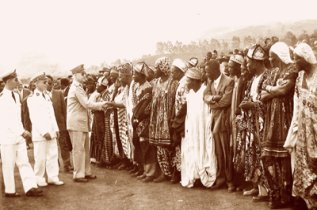Cameroon gained its name from what Portuguese settlers had named the River of Shrimp, Rio dos Camarones, after they reached the coast in 1472. The history of Cameroon pretty much followed the usual course over the subsequent centuries with slavery and trade being the main focus of the land's contact with the west. In 1884 the German Empire claimed the territory during the Scramble for Africa and it became known as the Colony of Kamerun. After Germany's defeat in World War I, Kamerun became a League of Nations Mandate territory being split into British Cameroon and French Cameroun in 1919.
While the French adopted their part of Cameroon into France, the British merely administered their mandates of Northern Cameroons and Southern Cameroons from their other nearby colony of Nigeria, effectively making the British Cameroons a colony of a colony. This did not go down well with their new 'subjects'. By 1946, when both mandates were renewed as UN Trusteeships, French Cameroun was pressing hard for independence, a movement coordinated by the Union of the Peoples of Cameroon which was founded on April 10, 1948, while the British, aware that the political tide was turning, pondered whether to let their part of the country merge with that held by the French or to incorporate it within Nigeria.

In the event, French Cameroun (above) gained independence from France on 1st January 1960 as the Republic of Cameroun under President Ahmadou Ahidjo and, the following year, Northern Cameroons voted to be integrated into the newly independent Nigeria, whilst Southern Cameroons opted to be part of the newly emerging Federal Republic of Cameroon under the stewardship of President Ahmadou Ahidjo (below), the then leader of French Cameroun. Despite independence, the country was still marred by guerrilla tactics from the rebel Union des Populations du Cameroun (UPC) and President Ahidjo used this conflict as a means to strengthen the presidency making his party, the Cameroon National Union (CNU), the country's only political force in 1966.
The federal system of government which had given the former Southern Cameroons relative autonomy was abolished in 1972 and the country was reborn as the United Republic of Cameroon that year. This loss of autonomy for Southern Cameroons created a strong movement there to break away and form the independent Republic of Ambazonia. Indeed this was proclaimed in 1999 but has gained no recognition either within or outside of Cameroon. President Ahmadou Ahidjo was re-elected president in 1965, 1970, 1975, and 1980 however he resigned on 4 November 1982 citing health issues.

Ahidjo was succeeded by his prime minister Paul Biya, however, they soon fell out and Ahidjo was forced into exile the following year, dying in Senegal in 1989. During this period, Biya effectively wiped his predecessor's rule from history removing his supporters from office and replacing all images of the country's first president with his own. Biya remains in office to this day and he maintains a firm grip on power however there has been a movement towards democratic reform with the introduction of multi-party politics. He is now the second-longest-ruling president in Africa and the longest-serving non-royal leader in the world. The video below explores Cameroon's history in more detail.

